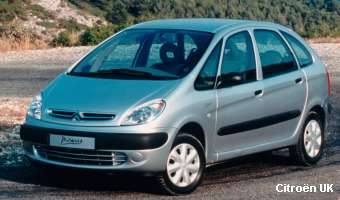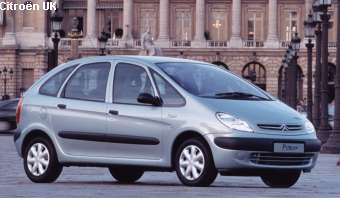
|
|
| CitroŽn Xsara Picasso - by Brian G. Thornton - December 1999 |
|
Whatís in a name? A lot, it seems, especially when that name is Picasso. It was the family of the late and famous artist Picasso which was looking for a product with which to associate their famous family name. They came to Citroen at its Creative Centre in Paris, which was preparing its MPV people carrier based on Xsara, and thus was born the Xsara Picasso. There was a legal wrangle, but this affected the Picasso family - and one of the settlement terms is no disclosure of the fees paid for the use of the Picasso name. "The cost was relatively low and the recognition figures [of Picasso] are greater than Xantia after six months" according to a Citroen France spokesperson. |

|
|
Officially, the product is known as Citroen Xsara Picasso. In reality this will be abbreviated by customers to Citroen Picasso, following the example of the Renault Mťgane Scenic, now simply Renault Scenic. When it goes on sale here in May it will have a specification and entry price aimed squarely at the Scenic. The comparison wouldnít end there for Picasso is a car in a very similar vein, and Picasso will have an engine choice of 1.6-litre 70kW/95bhp (up from 65kW/90bhp in the launch car we drove), a 1.8 16-valve 85kW/117bhp petrol, or two litre 66kW/90bhp HDi Common Rail Diesel. Shaped like Scenic, and sharing the five-seat formula rather than six seats as in the Fiat Multipla or seven as in the Opel / Vauxhall Zafira, Citroen studies have shown that on average occupancy of compact MPVs is 1.8 persons, and seldom are more than five persons required to be transported. Luggage is important, and here Picasso offers 550 litres/19 cubic feet of space. There is also a unique feature - supermarket Modubox Ďwheely-biní that folds away flat in the boot when not in use. Given the emphasis on reducing numbers of plastic bags from supermarkets, this must be one of the memorable features offered by the Citroen Picasso. Citroen claims that having a third row of seats, like Zafira means placing passengers in the crumple zone - that portion of the rear of a car that collapses on impact from behind in order to minimise injuries to those on board. Picasso offers a long measurement from accelerator to rear seats, 1.71m and 1.49m elbow room so those on board have lots of space. Rear seats fold when not in use and may be unclipped and removed entirely to enable bulky loads to be carried. However, Citroen has not followed the example of the Zafira or the Toyota Yaris Verso with rear seats that collapse flat into the floor well. |
|

|
Picasso is due for launch in May. Driving each this week, we noted the great pulling power and top speed of the new Diesel Common Rail unit, while the 16 valve 1.8 also gave good account of itself. The 1.6-litre has only eight valves and ran out of puff on a motorway stretch! By the time Picasso reaches these shores, this unit will be retuned to 95bhp, compared with 90bhp on the launch version. All models come with 12-year anti-corrosion, three-year paint and one year mechanical warranties plus roadside assistance. BTW, the Picasso's brother, the Citroen Berlingo Multispace (the cheap but cheerful van-derived people carrier) will have a sliding left-side door from January. Currently its sales have been hampered by being a 3-door van body. |
| [This Week] [Full Contents] [News] [Features] [Car of the Week] [Motorsport] [A-Z] |